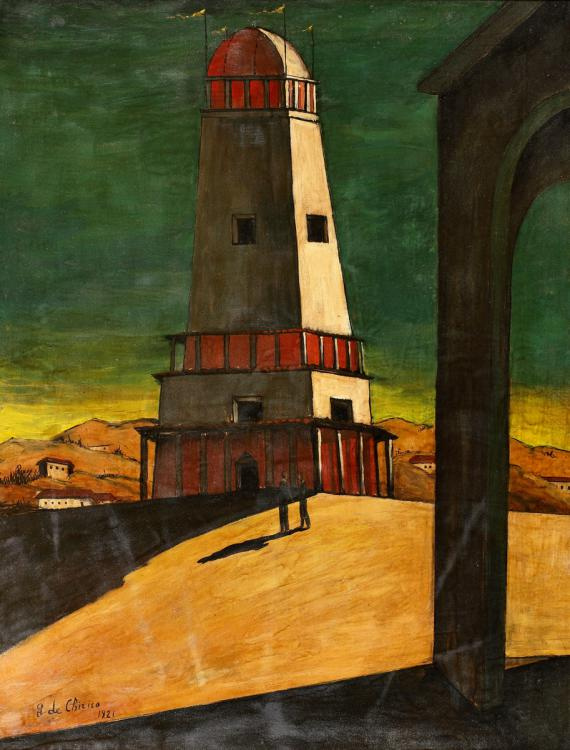log in
Enter site
Login to use Arthive functionality to the maximum
The Big Tower
Giorgio de Chirico • Painting, 1921, 83×62 cm
Description of the artwork «The Big Tower»
The Big Tower is characteristic of Chirico’s early, metaphysical period. It alludes to his earlier canvas, one of the most celebrated, The Nostalgia of the Infinite, painted between 1911 and 1913. Compositionally, the two pictures are very similar, but the viewpoint in The Nostalgia is lower. Besides, the shadows and lighting in The Big Tower tell us that the setting sun is very low.
It is a feature peculiar to Chirico’s paintings, making them recognizable: his landscapes are brightly lighted — usually by the setting sun (even the classical antique busts in his pictures sometimes wear sunglasses). But Chirico would not deserve the status of a metaphysical painter if he did not have a purpose of perplexing the viewers, making them uncertain about the objects they can see every day and pay but little attention to. That is why it is sometimes impossible to say where the source of light in his pictures is. The painter plays with light and shadow, uses unusual perspective, loud colors, and unconventional architectural elements. De Chirico remarked, ‘…every object has two appearances: one, the current one, which we nearly always see and which is seen by people in general; the other, a spectral or metaphysical appearance beheld only by some individuals in moments of clairvoyance and metaphysical abstraction, as in the case of certain bodies concealed by substances impenetrable by sunlight yet discernible, for instance, by X-ray or other powerful artificial means.’ In his works, the painter might have tried to show this concealed appearance of objects.
De Chirico confessed that all his pictures painted in the period between 1912 and 1915 are marked with Italian influence. Born and grown up in Greece, a country with history as rich as that of Italy, he was awestruck when he first came to Milan. During that period, he painted the Italy’s Squares series where he focused on old buildings and vast, sunlit, empty spaces, flavoring his pictures with surrealistic details. Chirico’s cityscapes often look desolate, even if there are people in them. In this respect, The Big Tower, painted in 1921, even seems more Italian than its prototype. The very air here seems motionless, and the people are just mute background actors.
It is a feature peculiar to Chirico’s paintings, making them recognizable: his landscapes are brightly lighted — usually by the setting sun (even the classical antique busts in his pictures sometimes wear sunglasses). But Chirico would not deserve the status of a metaphysical painter if he did not have a purpose of perplexing the viewers, making them uncertain about the objects they can see every day and pay but little attention to. That is why it is sometimes impossible to say where the source of light in his pictures is. The painter plays with light and shadow, uses unusual perspective, loud colors, and unconventional architectural elements. De Chirico remarked, ‘…every object has two appearances: one, the current one, which we nearly always see and which is seen by people in general; the other, a spectral or metaphysical appearance beheld only by some individuals in moments of clairvoyance and metaphysical abstraction, as in the case of certain bodies concealed by substances impenetrable by sunlight yet discernible, for instance, by X-ray or other powerful artificial means.’ In his works, the painter might have tried to show this concealed appearance of objects.
De Chirico confessed that all his pictures painted in the period between 1912 and 1915 are marked with Italian influence. Born and grown up in Greece, a country with history as rich as that of Italy, he was awestruck when he first came to Milan. During that period, he painted the Italy’s Squares series where he focused on old buildings and vast, sunlit, empty spaces, flavoring his pictures with surrealistic details. Chirico’s cityscapes often look desolate, even if there are people in them. In this respect, The Big Tower, painted in 1921, even seems more Italian than its prototype. The very air here seems motionless, and the people are just mute background actors.


